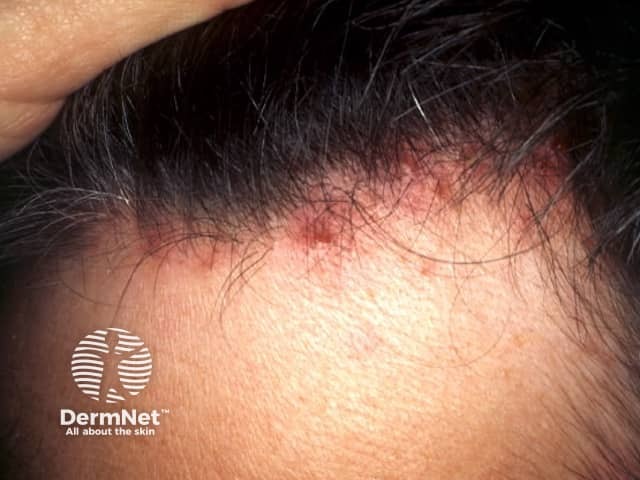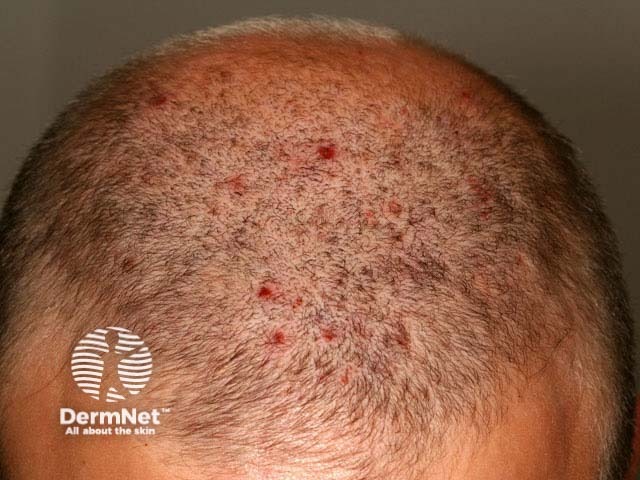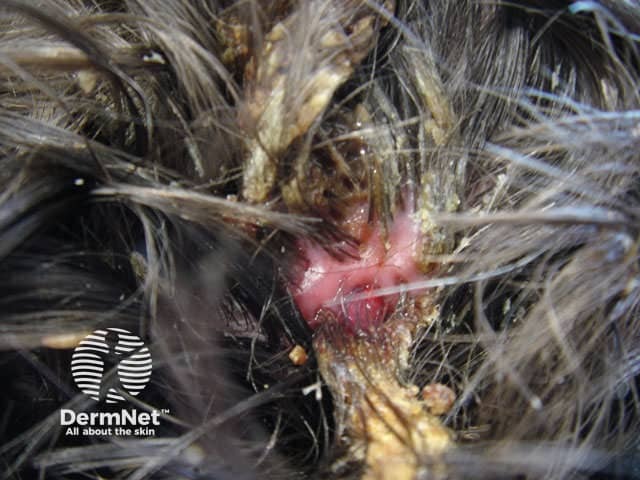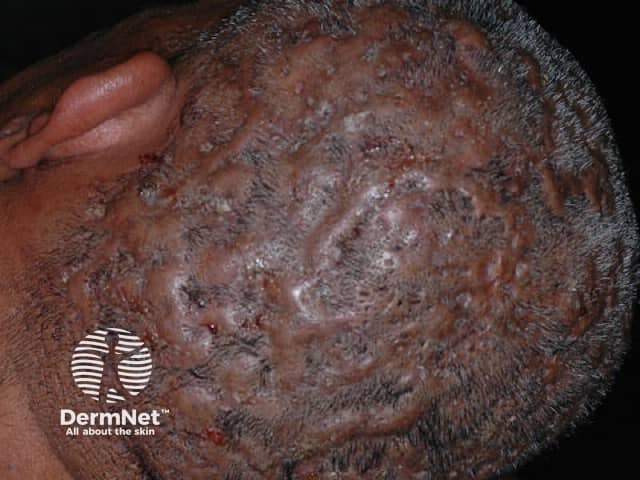Main menu
Common skin conditions

NEWS
Join DermNet PRO
Read more
Quick links
Scalp folliculitis — extra information
Scalp folliculitis
Author: Reviewed and updated by Dr Amanda Oakley, Dermatologist, Hamilton, New Zealand; Vanessa Ngan, Staff Writer; Clare Morrison, Copy Editor, June 2014.
Introduction
Causes
Treatment
Acne necrotica
Perifolliculitis capitis abscedens et suffodiens
What is scalp folliculitis?
Scalp folliculitis is an inflammatory disorder of the hair follicles in the scalp. The condition is also known as "acne necrotica miliaris" or "Proprionibacterium folliculitis".
Scalp folliculitis is characterised by small, very itchy pustules on the scalp, often most troublesome on the frontal hairline. There may be only a small number of lesions, or they may be very numerous. They are hard to leave alone because of the itch. They often become sore and crusted.

Scalp folliculitis

Scalp folliculitis

Scalp folliculitis
See more images of scalp folliculitis.
What is the cause of scalp folliculitis?
The cause of scalp folliculitis is not well understood. It is generally considered to be an inflammatory reaction to components of the hair follicle, particularly the micro-organisms. These include:
- Bacteria (especially Cutibacterium acnes, but in severe cases, also Staphylococcus aureus)
- Yeasts (Malassezia species)
- Mites (Demodex folliculorum)
What is the treatment for scalp folliculitis?
The scalp affected by folliculitis should be washed with a mild normal shampoo as often as desired. Antidandruff shampoos containing antifungal agents such as ketoconazole or ciclopirox are sometimes helpful. Conditioner can be used if desired.
The following medications may be helpful for scalp folliculitis:- Topical antibiotics (eg, fusidic acid gel), clindamycin solution, erythromycin solution
- Mild topical steroid lotions or creams
- Oral antihistamines
- Oral antibiotics, particularly long-term tetracycline
- Oral isotretinoin – long-term low dose treatment may be required
What is acne necrotica?
Acne necrotica is a more severe form of scalp folliculitis also known as acne varioliformis or acne frontalis. Larger follicular spots (papules) become inflamed then develop blackened crusts, finally leaving permanent pox-like scars. Acne necrotica may affect the face, scalp or other areas.
What is perifolliculitis capitis abscedens et suffodiens?
Perifolliculitis capitis abscedens et suffodiens is also known as dissecting cellulitis/folliculitis, or perifolliculitis capitis.
Perifolliculitis capitis abscedens et suffodiens is a rare and severe form of scalp folliculitis sometimes associated with acne conglobata, hidradenitis suppurativa and spinal arthritis (spondyloarthropathy). It most often affects black adult men but may rarely occur in white-skinned individuals, females, and children.
Large nodules and cysts accompany smaller follicular papules and pustules, from which purulent material can be expressed. Temporary hair loss over the lesions eventually results in permanent scarring and bald patches.
Perifolliculitis capitis abscedens et suffodiens is very resistant to treatment. The severity may be reduced with oral isotretinoin, antibiotics, dapsone and injected or systemic steroids. Compression of fluctuant nodules has also been reported to be of benefit.

Perifolliculitis capitis abscedens et suffodiens

Perifolliculitis capitis abscedens et suffodiens

Dissecting cellulitis
On DermNet
- Follicular occlusion syndrome
- Folliculitis keloidalis
- Folliculitis decalvans
- Diagnosis of scalp rashes
- Hair and scalp
- Melanoma in skin of colour
- Facial acne images
- Perifolliculitis capitis abscedens et suffodiens
On other websites
- Perifolliculitis Capitis Abscedens Et Suffodiens — Medscape Reference
- Dissecting cellulitis of the scalp — British Association of Dermatologists
